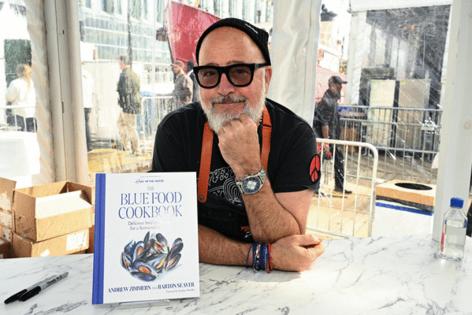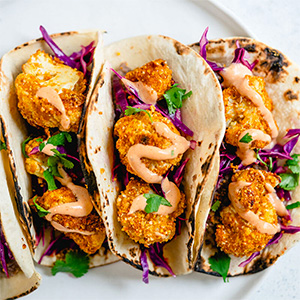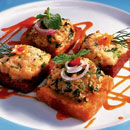Andrew Zimmern conquers seafood in his latest cookbook
Published in Variety Menu
When talking about his latest cookbook, chef and television personality Andrew Zimmern had an epiphany.
“My first job in food was when I was 14 when my parents said no allowance, so I went and got a job at the local seafood restaurant that my godmother owned,” he said. “I was telling someone that the other day, when I realized, wow, it’s my 50th year in food and cooking essentially uninterrupted.”
Zimmern has come a long way since those days shucking clams and oysters and frying fish at the Quiet Clam in East Hampton, New York. As a young chef in his 20s, he worked in kitchens in Hong Kong, Paris, Venice and New York City. “I just cooked a lot of seafood and just naturally drifted towards it,” he said.
That affection for things that go bump in the water has come full circle for the Minnesota-based Zimmern, who recently released “The Blue Food Cookbook: Delicious Seafood Recipes for a Sustainable Future,” a seafood- and fish-centric recipe and companion book he co-authored with chef/ food educator Barton Seaver.
“I was thrilled to collaborate with Barton. He’s a good friend and someone who knows what he’s talking about,” Zimmern said. “Between the two of us, I think we’re able to cover every base and I think we created something pretty fun.”
The 400-page catalog features 145 recipes and acts as a comprehensive guide to sourcing and cooking fish. The duo collaborated with the nonprofit Fed by Blue, a marine and aquatic conservation group, as they aim to cast seafood in a whole new light. (Zimmern also worked with the nonprofit on last year’s Emmy-nominated PBS docuseries “Hope in the Water,” from his Intuitive Content production company.)
Throughout the book, the authors make the argument for eating more fish, which has a lower carbon footprint than land-based animals. Some brands, species and fisheries are more problematic than others, they say, but there have also been great strides.
“I think that if we want to improve our ecosystems around the world, we can do it by incorporating well-managed wild fisheries and well-managed farms … aquaculture situations,” Zimmern said, referring to the practice of sourcing fish and plants from controlled water bodies and marine environments to move away from overfishing in oceans.
The chefs make the case that frozen can be just as delectable as fresh fish, pointing out that technology on boats is so advanced that the day’s catch is flash-frozen on the spot, preserving peak freshness.
They also hope to demystify the perception that fish and seafood are too expensive. Living in landlocked Minnesota, Zimmern has experienced that firsthand when shopping.
“I was at a local supermarket where whole fillets of sockeye were on sale for about $11 a pound. And I looked at where they were selling meat, and chicken and beef at that point were more expensive than the salmon,” he said. “The salmon had been frozen meticulously ... and it was delicious.”
The book‘s recipes are wide-ranging, featuring tinned fish, bivalves, shelled, freshwater fish, seafood and more. They also offer domestic and worldly flair, such as New England clam chowder, crab cakes, linguine with clam sauce, aguachile, steamed black bass with ginger, garlic and scallions, and Vietnamese-style caramelized shrimp. Plus one that might be more familiar.
Living in the Land of 10,000 Lakes, Zimmern said, “I had to put my Minnesota shore lunch recipe in there.”
Scallop Aguachile
Serves 4.
“I love raw seafood, I love spicy, sour, and tart things, and I love herbs and cucumbers. So, it’s no surprise that long ago when I first ventured to coastal Mexico, I fell in love with aguachile, the dressing of seafood with ‘chile water,’” writes chef and author Andrew Zimmern. His friend chef Claudette Zapeda, “the queen of aguachile,” revealed some of her secrets to help inform this recipe. From “The Blue Food Cookbook,” by Andrew Zimmern and Barton Seaver (Harvest, 2025).
8 oz. tomatillos, chopped
½ bunch cilantro, chopped
⅓ c. chopped scallions
1 ½ tsp. honey
1 serrano chile, stemmed
1 c. coconut water
¼ c. lemon juice (about 2 lemons)
¼ c. lime juice (about 4 limes)
½ large English cucumber, chopped (about ½ cup)
Salt
1 lb. fresh jumbo dry-pack sea scallops, sliced across in half or thirds
1 tsp. toasted fennel seeds
1 carrot, steamed and cooled, thinly sliced into rings (about ½ c.)
1 small Persian cucumber, thinly sliced into rings (about 1 c.)
1 shallot, thinly sliced into rings (about ¼ c.)
½ c. mint leaves (from about 4 sprigs), and mint flowers if you have them
½ c. cilantro leaves (from about 4 sprigs)
½ c. edible flowers
Directions
Combine the tomatillos, chopped cilantro, scallions, honey, chile, coconut water, lemon and lime juices, English cucumber and salt to taste in a blender and blend until homogenous. Strain through a fine-mesh strainer or a strainer lined with cheesecloth and discard the solids. Season the liquid again as needed, then cover and refrigerate for at least 2 hours.
Place 4 to 5 ounces of aguachile into four ice-cold low-sided wide bowls. Divide the scallops among the bowls. Sprinkle each with the fennel seeds and salt. Arrange the carrot discs, Persian cucumber rings and shallot rings around each bowl. Arrange the mint and cilantro leaves and flowers around the bowls. Serve immediately.
Poached Salmon With Hollandaise
Serves 6 to 8.
This is a classic salmon dish with a no-fail hollandaise sauce to have on repeat, according to Andrew Zimmern, who writes: “Every cook should know how to make this dish. I love slicing cucumbers paper thin to create scales to decorate the fish or cover in a mixture of minced herbs and citrus zest. I even love serving this with a mountain of potato crisps on top. Garnish the platter with a medley of spring vegetables, cooked asparagus, herb sprigs, or all of the above. This is a show-off dish, so show off!” From “The Blue Food Cookbook,” by Andrew Zimmern and Barton Seaver (Harvest, 2025).
1 (2- to 3-lb.) salmon fillet, skin-off, pin bones removed, tail removed
Salt
3 c. dry white wine
1 onion, chopped (about 1 c.)
3 ribs celery, chopped (about 1 ½ c.)
1 tbsp. whole black peppercorns
3 parsley sprigs
3 dill sprigs
3 tarragon sprigs
No-Fail Hollandaise (see recipe)
Directions
Season the fish with salt and set it aside.
Make the poaching liquid by combining the wine, onion, celery, peppercorns, parsley, dill, tarragon and salt to taste in a fish poacher or deep rectangular pan large enough to hold the salmon. Add 3 to 4 inches of water and bring to a boil. Place the salmon fillet on an oiled piece of butcher paper with edges that stick out over the sides of the pan, or on a large piece of cheesecloth. (This is to remove the fillet without it breaking if you don’t have a specialized salmon poacher pan.) Lower the salmon fillet into the liquid and bring the bouillon back to a simmer. Lower the heat to maintain the barest simmer possible, cover, and cook gently until the salmon is just cooked through, 12 to 16 minutes, depending on the thickness. Turn off the heat and let the fish rest in the liquid for 2 to 3 minutes.
Lay a towel next to a platter. Using the paper or cheesecloth, remove the fish from the liquid and place on the towel. Dab the fish dry as best as possible. Carefully transfer the salmon to a platter. Garnish with any accoutrements you’d like, such as cucumber slices or herbs and citrus.
Serve the warm with the No-Fail Hollandaise.
No-Fail Hollandaise
Makes about 1 ½ cups.
From “The Blue Food Cookbook,” by Andrew Zimmern and Barton Seaver (Harvest, 2025).
2 tbsp. fresh lemon juice, or more to taste (about 1 lemon)
1 tsp. Dijon mustard
2 tbsp. freshly minced fresh tarragon leaves
⅛ tsp. cayenne pepper
5 egg yolks
1 c. (2 sticks) butter, cut into ¼-in. pieces
Salt
Directions
Set up a pot of gently simmering water over which you can rest a stainless-steel bowl. In that bowl, whisk together 1 ½ tablespoons water, the lemon juice, mustard, tarragon, cayenne and egg yolks until thickened, 2 to 3 minutes. Whisk continuously, removing the pan from the heat source briefly if it gets too hot. Add the butter, whisking constantly until the butter is fully incorporated, about 2 minutes. Season with salt. Whisk over the heat to make sure the sauce is warm. (Your yolks are already cooked and stabilized.)
If the sauce is too thick, whisk in warm water, 1 teaspoon or so at a time, until the sauce is just pourable.
This sauce can be made ahead by about an hour if kept stored in a plastic quart container in a pot of hot water. You can store leftovers in an airtight container in the refrigerator for up to a week and reheat in a double boiler over low heat.
Minnesota Fish Fry
Serves 6 to 8.
“The most traditional meal in Minnesota is the shore lunch and the most traditional shore lunch is a fish fry. And it’s not just for Friday nights! At the cabin on the lake, this is a regular meal anytime someone pulls the boat up with some lake fish, especially walleye, our state fish,” writes Zimmern, who adds that if you don’t have walleye, use any mild, tender white-fleshed fish. From “The Blue Food Cookbook,” by Andrew Zimmern and Barton Seaver (Harvest, 2025).
3 quarts vegetable oil
2 c. all-purpose flour
Salt and freshly ground white pepper
3 eggs, beaten
2 sleeves Ritz crackers, pulsed in food processor until finely crushed (about 2 c.)
2 to 3 lb. walleye fillets, trimmed and cut into 3- to 5-ounce pieces
4 russet potatoes, baked the night before (see Cooking Tips)
Coleslaw, for serving
Tartar sauce, for serving
Lemon wedges, for serving
Directions
Heat the oil in a deep pot or Dutch oven over medium heat to 375 degrees.
To prepare the fish: Spread the flour out onto a plate and season very well with salt and white pepper. Beat the eggs in a wide bowl. Place the crushed crackers in another bowl. Season the fish with salt and white pepper. Dredge the fish in the flour mixture. Dip into the beaten egg, coating well, and then into the cracker crumbs. Working in batches, fry the fish pieces until golden brown, about 5 minutes. As the fish come out of the fryer, place on paper towels to drain and season with salt.
To prepare the potatoes: Return the frying oil to 375 degrees. Break the cold baked potatoes with your hand for a rustic look. Add the potatoes to the frying oil and fry until golden brown and very crispy, about 6 minutes. Drain on paper towels and season with salt.
Serve the walleye and potatoes with coleslaw, tartar sauce and lemon wedges.
Cooking tips: Make the potatoes the day before. Use russet potatoes that are washed, dried, pricked with a fork, and baked for 90 minutes in a 350-degree oven, or until tender. Cool and refrigerate unwrapped overnight.
“The Blue Food Cookbook” has recipes for both coleslaw and tartar sauce. While store-bought can be used, Zimmern writes “I beg you to make your own.”
©2025 The Minnesota Star Tribune. Visit at startribune.com. Distributed by Tribune Content Agency, LLC.















Comments